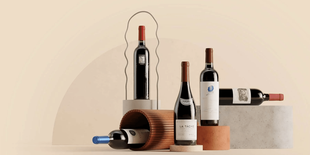Vinovest Quarterly Report Q2 2024
Spring marks an exciting time for fine wine and whiskey, and this year was no exception. We saw historically low prices unfold at Bordeaux en primeur. We witnessed vintage-altering weather in Burgundy. Plus, we celebrated an important milestone in whiskey investing.
Let’s dig into that and more with the Vinovest quarterly report.
Further reading
In case you missed it, you can look back on Vinovest Quarterly Report Q1
By The Numbers
0.58% - The average return for wine in Vinovest-managed portfolios
-2.44% - The average return for wine on the Liv-ex 1000, an index that tracks 1,000 of the most investment-worthy wines
37.2% - The price drop from 2022 Château Mouton Rothschild to its newly released 2023 vintage. The drop helped make Mouton the most invested in en primeur wine at Vinovest.
$16 million - The amount invested into whiskey casks by Vinovestors since whiskey investing launched one year ago
Fine Whiskey Performance in Q2
The biggest whiskey story of the second quarter was our cask revaluations. But to understand it, you need to know what happens to your cask while it ages.
First, your whiskey develops more flavor. Second, it loses alcoholic strength. Third, and most importantly for this story, it decreases in volume due to evaporation.
Because wood is porous, casks “breathe” the surrounding air. While the cask breathes, it loses water and alcohol content. The evaporation rate, also known as the angel’s share, is typically 2% of the remaining volume per year.
Vinovest works with third-party specialists to evaluate and inspect casks once per year. These specialists monitor a cask’s contents and determine the current volume and alcoholic strength in a process known as re-gauging. These numbers allow us to calculate the re-gauged liters of alcohol (RLA) compared to the original liters of alcohol (OLA). RLA gives us clues about a whiskey’s maturity and the total losses due to angel’s shares.
Here’s the important part. Re-gauging allows us to determine a cask’s value. The value involves multiplying the estimated future price of the whiskey by the number of bottles that can be drawn from the cask. We call this future cask value (FCV).
In June, third-party specialists revalued Vinovest’s one-year-old American whiskey casks. Here are the new price valuations.

There are two main takeaways from these results. One is that every cask had a positive return. That included six mashbills increasing double-digits in price, led by straight bourbon (70% white corn, 20% rye, 10% barley) at 25.9%.
Second is the performance of that aforementioned straight bourbon. The casks contained white corn instead of the more commonly used yellow corn. White corn adds an earthy flavor to whiskey that commands a premium price, giving clients with this cask a reason for high spirits.
Fine Wine Performance in Q2
If the question is “Are we out of the woods yet?” the answer is no. The fine wine industry, while tantalizing close, has not yet seen the end of its price drop. In fact, the Liv-ex 1000, which tracks 1,000 of the most investment-worthy wines, has seen its index fall in 18 of the last 19 months.
Here’s an overview of the performance of major wine regions.
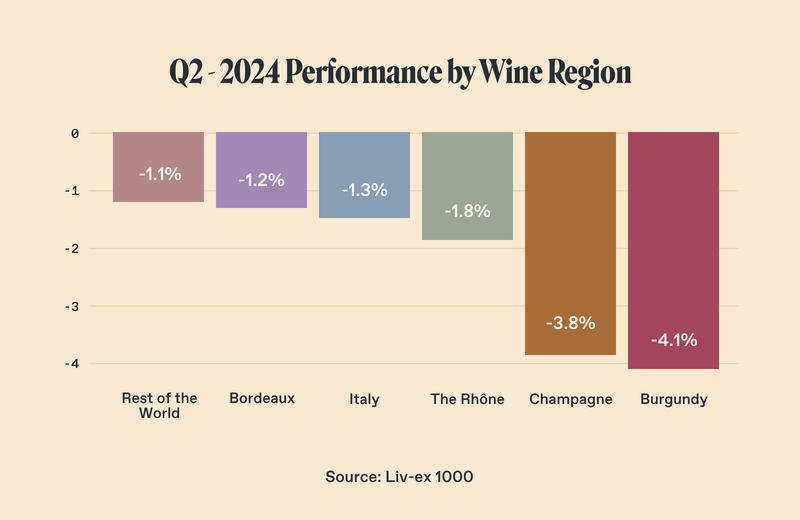
As meek as the wine market looks, there is reason for optimism. Recent analysis shows signs of life among blue-chip Burgundies, namely the hallowed estate, Domaine de la Romanée-Conti. Meanwhile, Super Tuscans have lived up to their name with a 0.5% return in 2024. That would make it the best-performing region if Super Tuscans were separate from other Italian wines like Barolos and Barbarescos.
Instead, the title of the best-performing region belongs to the Rest of the World, an index compromised largely of Napa Valley cult cabs. In the last month, the region has seen prices climb 0.8%, thanks to strong interest in back vintages of Screaming Eagle, Opus One, and Dominus. In fact, the small surge saw 2014 Screaming Eagle and 2012 Opus One notch double-digit returns for the month of May.

That’s not all. Managed wine portfolios at Vinovest have seen wines increase in value for the second time in three quarters. The average wine jumped 0.58% in price in the second quarter, outpacing the Liv-ex 1000 by three full points. That’s on the heels of a -2.18% dip in the first quarter and a 2.70% increase in the final quarter of 2023.
Q2 Wine Exits
Good times or bad times, great Champagne never goes out of style. In the second quarter, Dom Perignon was the most sold wine by our trading team. It accounted for 5.9% of wines exited, totaling more sales than all Napa Valley (5.8%) or the Rhône (5.7%).
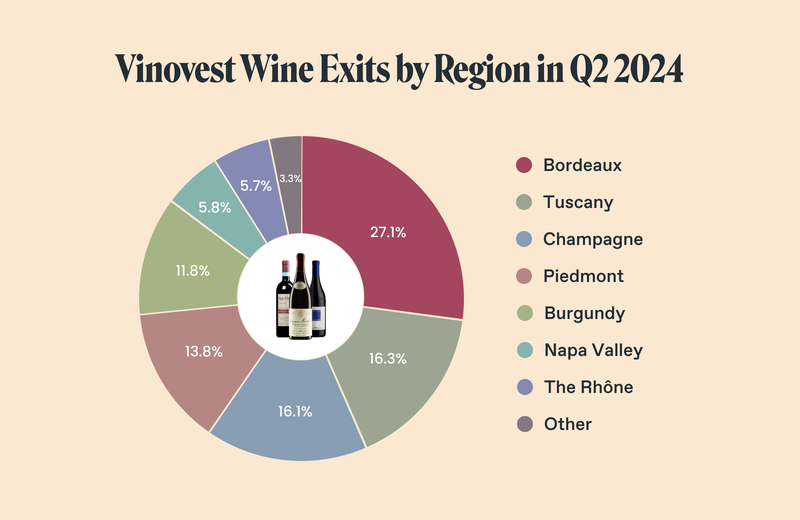
Sassicaia and Tignanello made up the second and third most exited wines of the second quarter. The 2017 vintage of Sassicaia proved a sage addition to any portfolio, with all but two cases of the 20 cases achieving positive returns. Meanwhile, the 2015, 2016, and 2017 vintages of Tignanello delivered the largest return for sellers.
Here’s a selection of notable second-quarter wine exits:

Investing Outlook for Q3 and Beyond
No one can predict the future. That doesn’t mean we can’t try. That’s why we asked our wine experts to peer into their crystal balls for a glimpse at what’s in store.
What is the market sentiment like in fine wine?
Olivier Bouchard, Winery Relations Manager: There is a growing consensus that we might have reached the bottom of fine wine’s price fall. The best indicator was this “special” 2023 Bordeaux en primeur campaign. Special because it featured the lowest average price since 2019, and it was still sluggish.
The big takeaway is that the market won’t accept insane prices anymore. There is still demand for high-quality wines but collectors and investors are interested in those with proven track records of appreciation and back vintages performing well in the current market.
Robbie Taylor, Head of Trading APAC & Global: 2024, like 2023, has been hard for most major wine regions. Speculative wines like blue-chip Burgundies have been hit hardest of all. That said, we are seeing the beginnings of stability, and with that comes consumer confidence.
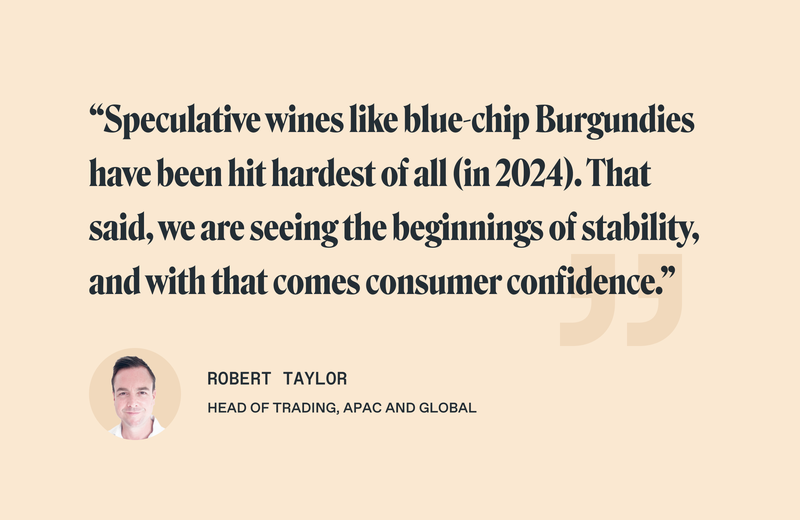
What will be the best-performing wine region for the rest of the year?
Robbie Taylor: Bordeaux is still the safest choice. The 2023 en primeur campaign was a strong message to the rest of the fine wine community. The improved prices should go a long way in restoring consumer confidence. I would also put my money into Super Tuscans, given their recent track record.
Olivier Bouchard: For me, it’s not a question of region but of vintage. The last few releases, whether from Bordeaux, Burgundy, or Champagne, have shown that there’s value in past vintages. The key is identifying the undervalued ones before other buyers.
What is an overlooked wine region or winery?
Olivier Bouchard: I’m going to copy my answer from the first quarter and say the Rhône. The region does not get the attention it deserves. The wines are age-worthy. Some producers have reached mythical status. Eventually, things should shift for this beautiful region.
Robbie Taylor: I’ve got two. Pym-Rae is owned by the Tesserons of Pontet-Canet fame. Their first vintage was only in 2016, and they recently received 100 points from The Wine Independent for their 2019 vintage. Meanwhile, Eisele is owned by the Artemis Group, the same owners as Château Latour. Their wines are spectacular and score well but are often underappreciated.
What else is on your mind?
Oliver Bouchard: Geopolitics. Tariffs, trade agreements, and political instability can significantly impact wine prices. The US election is worth watching, even if you don’t live in the States.
Robbie Taylor: China and Hong Kong. When will these two markets bounce back? There’s some evidence to suggest that they will lead the path to recovery. However, the Asian wine market has been in a slump lately, so it’s too early to see the light at the end of the tunnel.
The 3 Biggest Stories from Q2
1. 2023 Bordeaux: Vintage Report
En primeur is the most exciting (and exhausting) week in fine wine. It’s a chance for thousands of visitors to taste the latest vintage of Bordeaux before the wines are bottled. This year, our team drove 400+ miles and sampled 150+ wines over four days to better understand the 2023 vintage.
Here’s what they found out.

This year was more exciting than usual. That’s because our team learned early on through visits, tastings, and dinners that the vintage was higher quality than expected.
The growing season was defined by unseasonably cool summer and frequent storms. Château Angélus alone faced 47 storms between April and September, and yet claimed that it had “not one grape attacked by mildew.” Other châteaux did not face as much rainfall, a testament to the unique microclimates from château to château.
The summer finished with a burst of heat, allowing grapes to reach their full flavor potential. The harvest began early in September for many, though some of the cabernet sauvignon stayed on the vine longer to ripen further.
Uneven growing conditions among châteaux lead to variability amongst releases. The best reds displayed incredible freshness, delicacy, and elegance. Unlike the 2021 vintage, they were not austere and maintained masterfully restrained power pulsating beneath the top notes.
The white wines faired even better. Many of the dry whites we tasted had a marked opulence compared to their red counterparts, punctuated by pronounced tropical notes and round, fleshy profiles. Creamy is the word that often came to mind.
Some of our favorite wines of the vintage include:
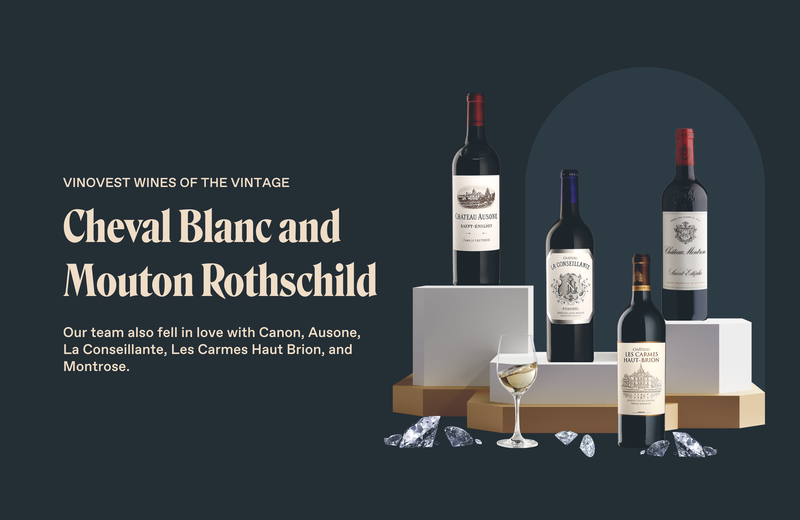
This year’s critic scores only reinforce the notion that certain wineries rose above the fray. The global wine marketplace Liv-ex tracked the ratings of 15 different critics and found that the 110 releases earned a combined 127 perfect scores. Leoville Las Cases and Cheval Blanc were the only two to gather double-digit perfect scores, with 11 and 10, respectively.
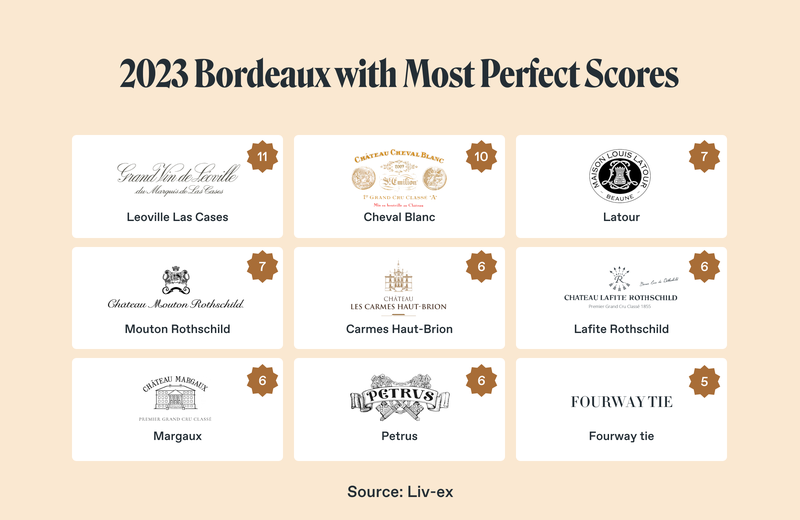
Price cuts defined the 2023 Bordeaux en primeur campaign. If you wanted to invest or drink your favorite Bordeaux (especially one out of your usual price range), this was the vintage for you. But how did we get here?
Simply put, great wine is complex and so is the industry’s economic situation. Over the past year, we’ve seen major markets like China reduce purchases, penalizing exchange rates in Japan and the UK, and an overstocking problem across the world. The result - a drop in the demand for fine wine mirrored by a decline in fine wine prices.
While at en primeur, our team consistently heard that the success of the campaign would hinge on release prices. Some winemakers were told this ad libitum, and although some didn’t appreciate the sentiment, we were surprised by how receptive many were to the idea.
Top châteaux that released wines early in the campaign set the tone. The average release was 22.5% lower than last year's average. Other wineries followed suit - sometimes begrudgingly - reinforcing the message to the market loud and clear.
Here are some of the most notable price cuts from the campaign.
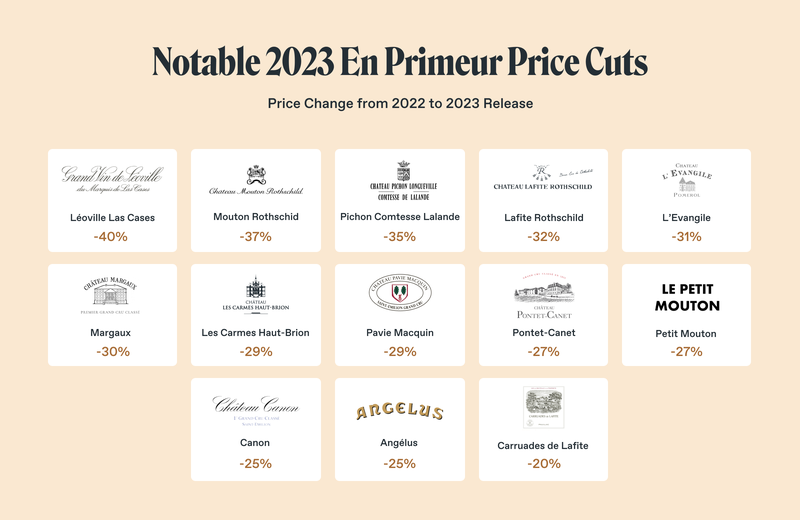
The price cuts were a promising sign for Bordeaux and the fine wine industry at large. However, some argue they didn’t go far enough. Wineries were asked to slash prices 30% to 35% in the lead-up to the campaign.
As Justin Gibbs, Liv-ex’s deputy chairman and exchange director, said in a Drinks Business article, “While the price cuts were a step in the right direction, what the market needed was a leap. For en primeur to be sustained, a new committed collector base will need to be found – and that might well require a price reset.”
The 2023 Bordeaux en primeur campaign was defined by dramatic price cuts. For many participants, it marked an opportunity to buy and drink beloved wines at the most affordable rate in a decade. And while they’re was no shortage of good deals in 2023, the best deals might just be among the 2014, 2017, and 2019 vintages.
Talk with a Vinovest portfolio advisor to learn how you can take advantage of these overlooked opportunities
2. Vinovest’s Whiskey Arm Celebrates 1-Year Anniversary
When we started Vinovest, we had one goal - democratize the world of fine wine. But that changed in 2023 when we launched our whiskey investing arm. Now, a full year later, we’re looking back at how far we’ve come in that time.
$16+ Million Invested
Assets under management went from 0 to $16 million real quick. In fact, 22% of Vinovestors invest in brown spirits. While a majority of them prefer American whiskey to its Scottish brethren, the most expensive and arguably most sought-after cask remains a barrel of Glenrothes single malt scotch that retails north of $145,000.
3 Countries Covered
Vinovest originally offered one type of whiskey - single malt scotch. But thanks to some strong and strategic partnerships, we’ve expanded to offer Irish and American whiskey. That includes unique barrels such as tripled-distilled Irish whiskey with a 100% malted barley mashbill to American single-malt whiskey finished in rum casks.
What type of whiskey should we offer next? Let us know with a comment in the Vinovest Community.
9 Successful Exits
Clients should expect to hold their American whiskey for 4 to 7+ years. However, some exit opportunities arose where it made sense to sell early, so we pounced. The result - nine successful exits for our clients.
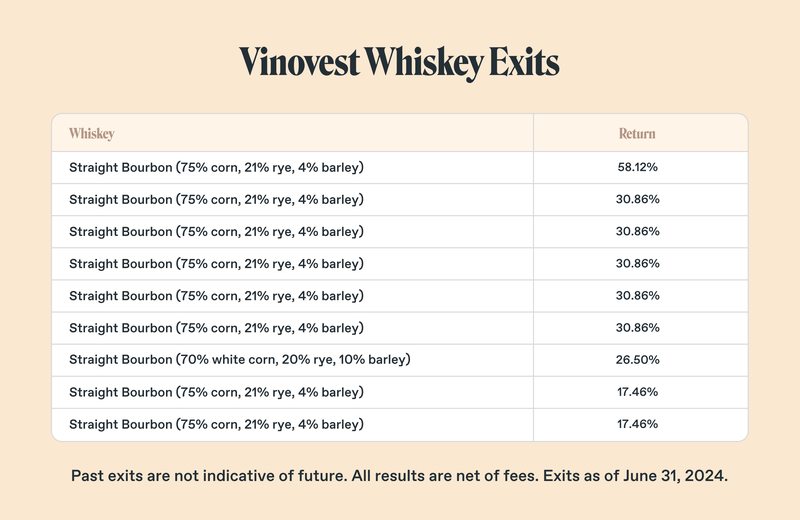
Straight bourbon (75% corn, 21% rye, 4% barley) has been in high demand and with good reason. The core mashbill is popular among sourced brands like Bulleit Bourbon and WhistlePig. This ubiquity makes the mashbill desirable to a large number of distilleries across the United States, not just a niche part of the market.
3. Hailstorm Hammers Burgundy's Chablis Region
In May, the fate of the 2024 Burgundy changed in the time it takes to read this quarterly report. A violent hailstorm hammered the vineyards of Chablis, an appellation known for its distinctive white wines. While the extent of the damage is still being accessed, it’s believed that vineyards sustained damage ranging from 30% to 100%.
Some estimates are more optimistic. “The hailstorm of the first of May has dramatically affected more or less 20 to 25 percent of the 15,000 acres of the appellation,” said Grégory Viennois, the former winemaker at Domaine Laroche, in a piece by Wine Spectator. “But with the wave of frost that we had the week before and the different episodes of hail that we had here and there since the beginning of the growing season, we can unfortunately expect that, at the end, the loss is [larger].”
Burgundy is no stranger to inhospitable weather. The region has a semi-continental climate that contributes to low annual yields. A single severe frost or hail can decimate a harvest, even limiting the production of some wines to a single barrel.
The Chablis hailstorm thus presents a silver lining in the wake of the damage. The reduced output should translate to upward pressure on prices when the 2024 vintage is released. In the meantime, it may contribute to increased interest in Burgundy back vintages on the secondary market.
Product Roadmap Spotlight
One of Vinovest’s company values is “Don't be a robot, build the robot.” We believe that by focusing on the right tools and processes, we can have an outsized impact on the client experience. Here are a couple of “robots” we built in Q2.

Autopay:In June, Vinovest launched autopay. It lets you set up automatic payments with a credit card or ACH to cover your monthly storage and insurance. That way, your payments are on time, every time. Plus, your cash balance is reserved exclusively for new wines and whiskeys, not fees.
You can step up autopay by:
Step 1: Logging into your Vinovest account
Step 2: Clicking “Settings.” Then clicking “Autopay Fees”
Step 3: Adding your payment method
Step 4: Clicking “enrolled” to enroll your account
Vinovest.com: Before there was Vinovest (our wine and whiskey investing platform), there was Vinovest - a South African company that made vests for bottles of wine. (Yes, you read that correctly.) This South African company owned the domain Vinovest.com, which is why our domain is Vinovest.co…until now.
In June, we acquired the Vinovest.com domain. All the redirects are live, meaning that if you accidentally email or search for Vinovest.com, you’ll be redirected to the right email inbox or site. That said, Vinovest.co will be our main page for the foreseeable future.
What should we work on next? Let us know by sharing your thoughts in the Vinovest Community.
In Case You Missed It
Bordeaux en primeur wasn’t the only exciting thing in the second quarter. While our traders tasted their way across the Gironde, the rest of the team formed new partnerships, attended industry conventions, and participated in several podcasts. Here are some of the highlights.
Uncorking the Art of Wine Investment Insights from Anthony Zhang of Vinovest, Episode #182 - Mitlin Money Mindset, April 24
Wine investing has long been for the few, not the many. In 2019, Anthony Zhang sought to change that by starting Vinovest with co-founder Brent Akamine. The Mitlin Money Mindset chronicles Anthony’s journey as a founder, including his challenges with quadriplegia and his mindset for success.
Vinovest Capital Whiskey Fund SPV - AltoIRA, April 26
Vinovest is teaming up with Alto Capital to offer a first-of-its-kind whiskey fund. Accredited investors can get access to rare American and Scotch whiskies through Alto’s Special Purpose Vehicles (SPV). The fund is designed not only to add ‘good spirits’ to portfolios but also to deliver attractive returns and insulation against economic downturns.
VHS Tapes, Whiskey, and Comic Books Are Emerging as an Investment Strategy. Here’s Why. - MarketWatch, May 31
Wine and whiskey aren’t for drinking anymore. They’re practically ways to grow and diversify your wealth. The latest piece from MarketWatch covers the boom of the alternative assets industry and how collectibles like wine and whiskey are increasingly playing a role in smart portfolio building.
Wine Investment Has a Promising Future With Technology Pushing it Forth - MarketScale, May 22
The traditional 60/40 portfolio is dying. In its place is a superior risk-adjusted model complemented by alternative assets like art, real estate, wine, and whiskey. Our CEO, Anthony Zhang, joined the MarketScale podcast to explore the shifting investing landscape and how technology is making these once-elusive assets more accessible.
